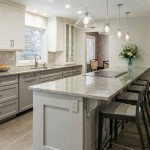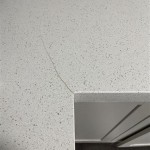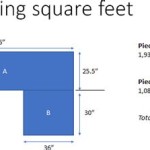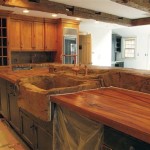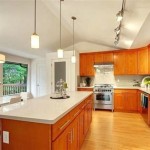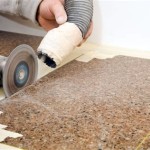The Comprehensive Guide to 13-Foot Butcher Block Countertops
Butcher block countertops have become increasingly popular in modern kitchens and workspaces, prized for their natural warmth, durability, and aesthetic appeal. A 13-foot butcher block countertop represents a significant investment and a substantial design statement, demanding careful consideration of material selection, installation techniques, maintenance practices, and potential drawbacks. This article provides a comprehensive guide to understanding and working with 13-foot butcher block countertops, ensuring a successful and long-lasting addition to any space.
The term "butcher block" originates from its traditional use in butcher shops as a reliable surface for cutting meat. Today, the term encompasses a wide range of wooden countertops constructed from various wood species and using different construction methods. Understanding these variations is crucial when selecting a 13-foot butcher block countertop.
A 13-foot length presents unique challenges and opportunities. The sheer size requires careful planning for transportation, installation, and ongoing maintenance. Longer spans are more susceptible to warping and bowing, necessitating understanding of the mitigating factors and preventative measures.
Understanding Butcher Block Construction
Butcher block countertops are typically constructed using one of three methods: edge grain, end grain, or face grain. Each method offers distinct advantages and disadvantages regarding appearance, durability, and cost.
Edge grain construction involves arranging long, narrow strips of wood on their edges, creating a surface with parallel lines. This is the most common and often the most affordable type of butcher block. Edge grain provides a durable surface that is relatively resistant to knife marks and wear. Its uniform appearance makes it a versatile choice for various kitchen styles. However, edge grain is generally less visually striking than end grain.
End grain construction features the ends of the wood pieces facing upwards. This method exposes the growth rings of the wood, creating a visually appealing mosaic pattern. End grain is considered the most durable butcher block option due to its self-healing properties. Knife marks tend to close up as the wood fibers expand and contract. End grain is also more resistant to moisture penetration because the end grain fibers are denser. However, end grain is typically the most expensive option, and its porous surface requires more frequent oiling and maintenance.
Face grain construction showcases the flat surface of the wood planks. This provides the widest grain pattern and offers a more consistent look than end grain but is less durable than either edge grain or end grain. Face grain is more susceptible to scratching and denting, making it less suitable for heavy-duty cutting tasks. It is often used for decorative countertops or islands where food preparation is minimal.
Choosing the Right Wood Species for a 13-Foot Countertop
The selection of wood species significantly impacts the durability, appearance, and maintenance requirements of a 13-foot butcher block countertop. Popular choices include maple, oak, walnut, cherry, and birch, each offering unique characteristics.
Maple is a popular choice due to its hardness, durability, and light color. It is resistant to scratches and dents, making it suitable for high-traffic kitchens. Maple is also relatively affordable compared to other hardwoods. However, maple's light color can make it prone to staining from spills and food particles.
Oak is another durable hardwood known for its distinctive grain pattern and warm tones. Oak is relatively resistant to moisture and decay, making it a good choice for kitchens with high humidity. However, oak's open grain can make it more susceptible to staining if not properly sealed.
Walnut offers a rich, dark color and a sophisticated appearance. It is a softer hardwood than maple or oak, making it more prone to scratches and dents. However, walnut's beautiful grain pattern and luxurious feel make it a popular choice for high-end kitchens.
Cherry is known for its reddish-brown hue and smooth texture. It is a moderately hard wood that is relatively easy to work with. Cherry will darken over time, developing a richer, more aged appearance. However, cherry is more susceptible to scratches and dents than maple or oak.
Birch is a light-colored hardwood that is similar to maple in appearance. It is a relatively affordable option and is easy to stain or paint. However, birch is less durable than maple or oak and is more prone to scratches and dents.
For a 13-foot countertop, considering the wood's stability is paramount. Some woods are more prone to warping or bowing over long spans. Consulting with a woodworker or countertop specialist to understand the specific properties of each wood species in relation to the length of the countertop is highly recommended.
Proper Installation and Support for Long Butcher Block Countertops
Installing a 13-foot butcher block countertop requires careful planning and execution to ensure stability and prevent warping. Proper support is crucial, especially given the length and weight of the countertop.
Substrate Support: A solid and level substrate is essential. This typically involves a cabinet base or a framework constructed specifically to support the countertop. The substrate should be designed to distribute the weight evenly across the entire length of the countertop. Any inconsistencies in the substrate can lead to stress points and potential warping.
Leveling: Ensuring the substrate and the countertop are perfectly level is vital. Use shims as needed to correct any minor imperfections. A level countertop will prevent strain and ensure proper alignment with surrounding fixtures, such as sinks and appliances.
Fastening: The countertop should be securely fastened to the substrate. Several methods can be used, including screws, bolts, and construction adhesive. Consider using slotted screw holes or expansion bolts to allow for natural wood movement. Wood expands and contracts with changes in humidity, and restricting this movement can lead to cracking or warping.
Mid-Span Support: For a 13-foot countertop, additional support in the middle is highly recommended. This can be achieved by adding a leg or a support bracket to the cabinet base or by installing metal bracing underneath the countertop. Mid-span support helps to prevent sagging and bowing over time.
Sealing: Before installation, apply a sealant to all sides of the butcher block, including the top, bottom, and edges. This helps to protect the wood from moisture and prevent warping. Use a food-safe sealant specifically designed for butcher block countertops.
Acclimation: Allow the butcher block to acclimate to the room's temperature and humidity for several days before installation. This will help the wood to adjust to its environment and minimize the risk of warping after installation.
The installation process is best left to experienced professionals who understand the nuances of working with large pieces of wood. Their expertise can ensure that the countertop is properly installed and supported, preventing potential problems down the road.
Beyond installation, ongoing maintenance is key to preserving the longevity and beauty of the butcher block. A regular oiling schedule helps to protect the wood from moisture, preventing warping and cracking. Selecting a food-safe mineral oil or a specialized butcher block oil is crucial. Avoid using vegetable oils, as they can become rancid over time.
Cleaning the butcher block should be done with a mild soap and water solution. Avoid using harsh chemicals or abrasive cleaners, as they can damage the wood. Promptly wipe up spills to prevent staining. Avoid placing hot pots and pans directly on the surface, as this can cause scorching. Use cutting boards for food preparation to minimize knife marks and wear.
Sanding the butcher block periodically can help to remove scratches and stains. Use a fine-grit sandpaper and sand in the direction of the grain. After sanding, reapply a coat of oil to protect the wood.
With proper installation and maintenance, a 13-foot butcher block countertop can provide years of beauty and functionality. It becomes not just a surface, but a focal point of the space.

Butcher Block Countertop Review Fletcher Creek Cottage

Options For Extra Long Countertops Because I Need A 20 Foot Countertop My Studio Addicted 2 Decorating

Allen Roth 8 Ft X 25 In 1 5 Finger Jointed Natural Acacia Butcher Block Countertop Arf1525fjaca 96 At Com

Butcher Block Kitchen Countertops At Com

My Butcher Block Countertops Two Years Later Wildfire Interiors

Installing Butcher Block Countertops Wildfire Interiors

How To Build Your Own Butcher Block Addicted 2 Diy

My Butcher Block Countertops Two Years Later Wildfire Interiors

Allen Roth 8 Ft Natural Acacia Butcher Block Countertop And Sink Collection

How To Build Your Own Butcher Block Addicted 2 Diy
See Also

